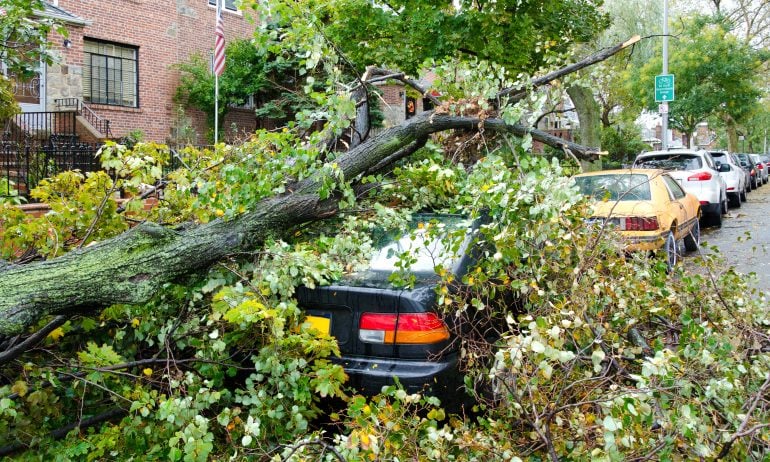The Difference Between Comprehensive and Collision Coverage

Many or all of the products featured here are from our partners who compensate us. This influences which products we write about and where and how the product appears on a page. However, this does not influence our evaluations. Our opinions are our own. Here is a list of our partners and here's how we make money.
Comprehensive and collision insurance are two of the most important types of car insurance to understand. They’re not legally required by any state, but they can come to the rescue in a variety of situations.
Collision and comprehensive coverage are often sold as a package. Both pay to fix damage to your own car or replace it entirely — but they don’t cover injuries or damage to anyone else’s property.
» MORE: What is auto insurance?

See what you could save on car insurance
Easily compare personalized rates to see how much switching car insurance could save you.Key terms in this article
Here are some common terms you will see associated with comprehensive and collision coverage.
A deductible is a set amount that is subtracted from a claim payout. When you buy your insurance policy, you select your deductible. If you choose a high deductible you will have a lower car insurance premium, but you will also pay more out-of-pocket if you make a claim. | |
Actual Cash Value | The value of your car in its current condition, not the price when you bought it or the trade-in value at a dealership. Cars decrease in value over time, so the actual cash value of your car will be less (sometimes significantly) than the purchase price. |
Comprehensive vs. collision insurance
The main difference between comprehensive and collision insurance is the situations covered. Collision insurance pays for damage to your car if you hit an object or another vehicle, while comprehensive coverage pays for theft or damage from causes such as bad weather, fire or fallen trees. Some insurers require that you purchase collision and comprehensive insurance together, while other insurers may allow you to purchase these two types of coverage separately.
Collision insurance pays for: |
|
Comprehensive insurance pays for: |
The actual cash value of your car if it's stolen and not recovered, and damage from:
|
For more in-depth information, see our guides to comprehensive insurance and collision insurance.
How much comprehensive and collision coverage cost
To get realistic comparisons, we analyzed rates in June 2024 for minimum-coverage policies and compared them with policies with comprehensive, collision and higher liability limits. Together these three types of coverage are commonly considered “full coverage” car insurance.
Here are median annual rates for 35-year-old drivers with good credit and no recent traffic violations or accidents at the largest auto insurance companies in the U.S. (In most states, drivers with good credit typically qualify for lower rates than those with poor credit. Four states — California, Hawaii, Massachusetts and Michigan — don't allow insurers to use credit in setting car insurance rates.)
| Company | Full coverage | Minimum coverage |
|---|---|---|
| Allstate | $2,258 | $617 |
| American Family | $1,279 | $477 |
| Farmers | $2,578 | $875 |
| Geico | $1,306 | $355 |
| Nationwide | $1,829 | $722 |
| Progressive | $1,725 | $491 |
| State Farm | $2,006 | $459 |
| Travelers | $1,405 | $435 |
| USAA* | $1,259 | $312 |
*USAA is only available to military, veterans and their families.
» MORE: Car insurance comparison tool
Car insurance rates vary widely by state for similar policies, and adding comprehensive and collision coverage costs more in some places than others. Below are the median rates for full and minimum coverage policies in every state for a 35-year-old driver with good credit and no recent tickets or accidents. Keep in mind that your own rate will depend on the value of your car, your location, your driving history and the deductible amount that you choose.
| State | Full coverage | Minimum coverage |
|---|---|---|
| Alabama | $1,716 | $402 |
| Alaska | $1,734 | $322 |
| Arizona | $2,085 | $636 |
| Arkansas | $1,764 | $446 |
| California | $1,638 | $459 |
| Colorado | $2,293 | $538 |
| Connecticut | $1,742 | $748 |
| Delaware | $1,995 | $864 |
| Florida | $3,067 | $811 |
| Georgia | $2,014 | $656 |
| Hawaii | $1,610 | $491 |
| Idaho | $1,162 | $320 |
| Illinois | $1,538 | $461 |
| Indiana | $1,421 | $404 |
| Iowa | $1,381 | $260 |
| Kansas | $1,806 | $470 |
| Kentucky | $2,394 | $666 |
| Louisiana | $3,037 | $887 |
| Maine | $1,234 | $387 |
| Maryland | $1,873 | $828 |
| Massachusetts | $1,296 | $399 |
| Michigan | $2,301 | $605 |
| Minnesota | $1,667 | $469 |
| Mississippi | $1,804 | $476 |
| Missouri | $1,967 | $506 |
| Montana | $1,738 | $422 |
| Nebraska | $1,432 | $329 |
| Nevada | $2,184 | $791 |
| New Hampshire | $1,119 | $368 |
| New Jersey | $1,986 | $801 |
| New Mexico | $1,835 | $440 |
| New York | $1,963 | $765 |
| North Carolina | $1,887 | $637 |
| North Dakota | $1,528 | $367 |
| Ohio | $1,209 | $335 |
| Oklahoma | $2,030 | $500 |
| Oregon | $1,346 | $602 |
| Pennsylvania | $1,696 | $367 |
| Rhode Island | $2,413 | $899 |
| South Carolina | $1,850 | $605 |
| South Dakota | $1,671 | $280 |
| Tennessee | $1,751 | $440 |
| Texas | $2,567 | $841 |
| Utah | $1,496 | $580 |
| Vermont | $1,082 | $310 |
| Virginia | $1,619 | $649 |
| Washington | $1,492 | $515 |
| Washington, D.C. | $1,737 | $859 |
| West Virginia | $1,667 | $498 |
| Wisconsin | $1,516 | $367 |
| Wyoming | $972 | $185 |

See what you could save on car insurance
Easily compare personalized rates to see how much switching car insurance could save you.How to save on comprehensive and collision insurance
As you can see, average annual rates can vary by hundreds of dollars, so it’s worth shopping around for car insurance quotes from several companies to make sure you’re getting the best deal.
Another way to save money is by raising your comprehensive and collision deductibles. An insurance deductible is a predetermined amount that is subtracted from a claim payout. Many policies offer options as high as $2,000. But do this only if you’re prepared to spend more of your own funds to fix or replace your car.
Do I need comprehensive and collision insurance?
About 80% of all U.S. drivers buy comprehensive coverage, and 76% buy collision, according to the Insurance Information Institute, which based its analysis on 2021 data from the National Association of Insurance Commissioners.
You should consider buying comprehensive and collision insurance if:
You lease your vehicle or took out a loan to buy it. Your lender or leasing company probably requires you to carry collision and comprehensive coverage.
You couldn’t afford to replace or significantly repair your car if you crashed it or someone stole it.
Your area has a high incidence of car theft, vandalism, severe weather (like hail) or animal collisions.
You probably don’t need comprehensive and collision insurance if your car is older and not worth a lot. Remember the maximum payout will be the value of your car if it’s totaled or stolen, minus the deductible.
If your car’s value is low, consider whether the potential payout would be worth the premiums you’ll pay. Remember, too, that the deductible amount will reduce any claims check.
NerdWallet averaged rates based on public filings obtained by pricing analytics company Quadrant Information Services. We examined rates for men and women for all ZIP codes in all of the 50 states and Washington, D.C. Although it’s one of the largest insurers in the country, Liberty Mutual is not included in our rates analysis due to a lack of publicly available information.
In our analysis, “good drivers” had no moving violations on record; a “good driving” discount was included for this profile. Our “good” and “poor” credit rates are based on credit score approximations and do not account for proprietary scoring criteria used by insurance providers.
These are median rates, and your rate will vary based on your personal details, state and insurance provider.
Sample drivers had the following coverage limits:
$100,000 bodily injury liability coverage per person.
$300,000 bodily injury liability coverage per crash.
$50,000 property damage liability coverage per crash.
$100,000 uninsured motorist bodily injury coverage per person.
$300,000 uninsured motorist bodily injury coverage per crash.
Collision coverage with $1,000 deductible.
Comprehensive coverage with $1,000 deductible.
In states where required, minimum additional coverages were added. We used the same assumptions for all other driver profiles, with the following exceptions:
For drivers with minimum coverage, we adjusted the numbers above to reflect only the minimum coverage required by law in the state.
We changed the credit tier from “good” to “poor” as reported to the insurer to see rates for drivers with poor credit. In states where credit isn’t taken into account, we only used rates for “good credit.”
For drivers with one at-fault crash, we added a single at-fault crash costing $10,000 in property damage.
For drivers with a DUI, we added a single drunken-driving violation.
For drivers with a ticket, we added a single speeding violation for driving 16 mph over the speed limit.
We used a 2021 Toyota Camry LE in all cases and assumed 12,000 annual miles driven. We analyzed rates for drivers of the following ages: 20, 30, 35, 40, 50, 60 and 70.
These are rates generated through Quadrant Information Services. Your own rates will be different.
On a similar note...


